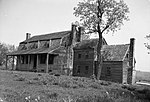Washington Executive Airport
1934 establishments in MarylandAirports established in 1934Airports in MarylandAirports in the Washington metropolitan areaDefunct airports in Maryland ... and 4 more
Maryland building and structure stubsMaryland transportation stubsSouthern United States airport stubsTransportation buildings and structures in Prince George's County, Maryland
Washington Executive Airport (FAA LID: W32), also known as Washington Executive Airpark or Hyde Field, was a public use general aviation airport located 2 miles (3.2 km) southwest of the central business district (CBD) of Clinton, in Prince George's County, Maryland, United States. The airport ceased operations on November 30, 2022, following a bankruptcy sale of the property. Hyde Field was one of the "Maryland 3" airports located within the Washington, D.C. Flight Restricted Zone (FRZ), so it was subject to the Special Flight Rules Area (SFRA) restrictions. It is located just 1.10 nautical miles (1.27 mi) east of a slightly smaller airport called Potomac Airfield.
Excerpt from the Wikipedia article Washington Executive Airport (License: CC BY-SA 3.0, Authors).Washington Executive Airport
Piscataway Road,
Geographical coordinates (GPS) Address External links Nearby Places Show on map
Geographical coordinates (GPS)
| Latitude | Longitude |
|---|---|
| N 38.748333333333 ° | E -76.932777777778 ° |
Address
Piscataway Road 10399
20735
Maryland, United States
Open on Google Maps






